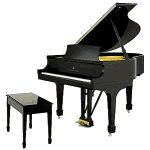

Composers from Amazon.com's Get Started in Classical:
| Bach | Glass | Schubert |
| Beethoven | Mahler | Stravinsky |
| Copland | Mozart | Tilson Thomas |
| Corigliano | Mutter | Wagner |
| Debussy | Pärt.htm | Zimerman |
| NEW! Huang Additional composers and musicians |
||
J.S. Bach
This is from Amazon.com's Get Started in Classical.
Bach's Magnificat is a gemlike masterpiece that displays the composer's many-sided genius The attitude of Johann Sebastian Bach (1685-1750) toward writing music was one of straightforward industriousness; indeed, the sheer bulk of his compositional legacy suggests something more like the efficiency of a factory than the struggles of the suffering artist. And yet, while churning out enormous quantities of music for his livelihood, Bach created masterpieces in every form he touched: these rank among the towering achievements of Western music and continue to evoke the deepest responses. Bach's sacred music, which accounts for a major portion of his output, is a good place to start. The Magnificat in particular contains many hallmarks of the composer's art. Its text is based on a passage from Luke in which Mary expresses her joy at the Annunciation: a recurrent formula for composers since the Renaissance, much like the countless paintings of the subject that are ubiquitous in art history. Bach here employs the fullest orchestra available to him and distributes the vocal writing for a five-part chorus as well as five soloists. There is constant variety among the 12 brief sections of the Magnificat to hold your attention, as textures shift from full choral settings to numbers for the soloists. The effect is rather like a mosaic, in which this variety is bound together in a unified, satisfying whole. Listen to the rush of joy in the very opening (track 10), as Bach pulls out all the stops with trumpets, timpani, and a rhythmic momentum that sets the pulse bounding. Bach is a master of expressive word painting: he illustrates and magnifies the meaning of the words in the musical shapes he uses to set them. Again, the Magnificat abounds in examples, such as the echo-like repetitions and layering of the chorus in "omnes generationes" (track 13) to suggest the proliferation of generations, or the plummeting descent of the tenor aria on "deposuit" ("he hath put down the mighty" [track 17]). Bach produces extremely memorable effects with the most economical means, as in the oboe's tender accompaniment to the soprano in "quia respexit" (track 12) to suggest the simultaneous innocence and rapture of Mary herself. On this recording you'll hear the kinds of instruments and techniques that would have been used in Bach's time, along with a relatively small chorus. Conductor J. Reilly Lewis strikes an ideal balance between the orchestra and voices, which is important to articulate the many strands of undulating melody that combine in Bach's style. Everything here is substantive: try to listen away from the most obvious top line and follow, for example, the bass to hear the richness contained in each component of the musical whole. Johann Sebastian was born into a family that had already made its mark as musicians for several generations, and a number of his own children went on to become famous musicians--proof if ever there was for a genetic aspect to musical talent. This recording opens with a Magnificat setting by his eldest son, Carl Philipp Emmanuel, whose fame during his lifetime eclipsed that of his father. The pairing allows for some intriguing comparisons: just one generation later than J.S. Bach's dense, richly wrought textures (the "baroque" style) comes a simpler, leaner sound that would be a crucial source for what is known as the classical style in the music of Haydn and Mozart. And yet there are traces of the past, and of the father's influence, in some of C.P.E. Bach's magnificent fugal passages. This is a particularly vivid example of the constant flux and evolution of styles that occur throughout music history.
Thomas May, Classical Editor
More Bach can be found in Musical Information, Recommendations for Adults, Recommendations for Children and the Listening Center
O'Connor Music Studio Recommendations lists Books, CD's, Cassette Tapes, Computer Programs, Music Scores DVD's, Videos and more from amazon.com, as well as several other sources.
Many thanks to Dearest for everything!
is located
in Fairfax, Virginia
Over 30 Years
~~
Piano, Organ
Electric Keyboard
Accompanying
Email Mary O'Connor
All rights reserved.
Site design and maintenance by
O'Connor O'Riginals Web Design